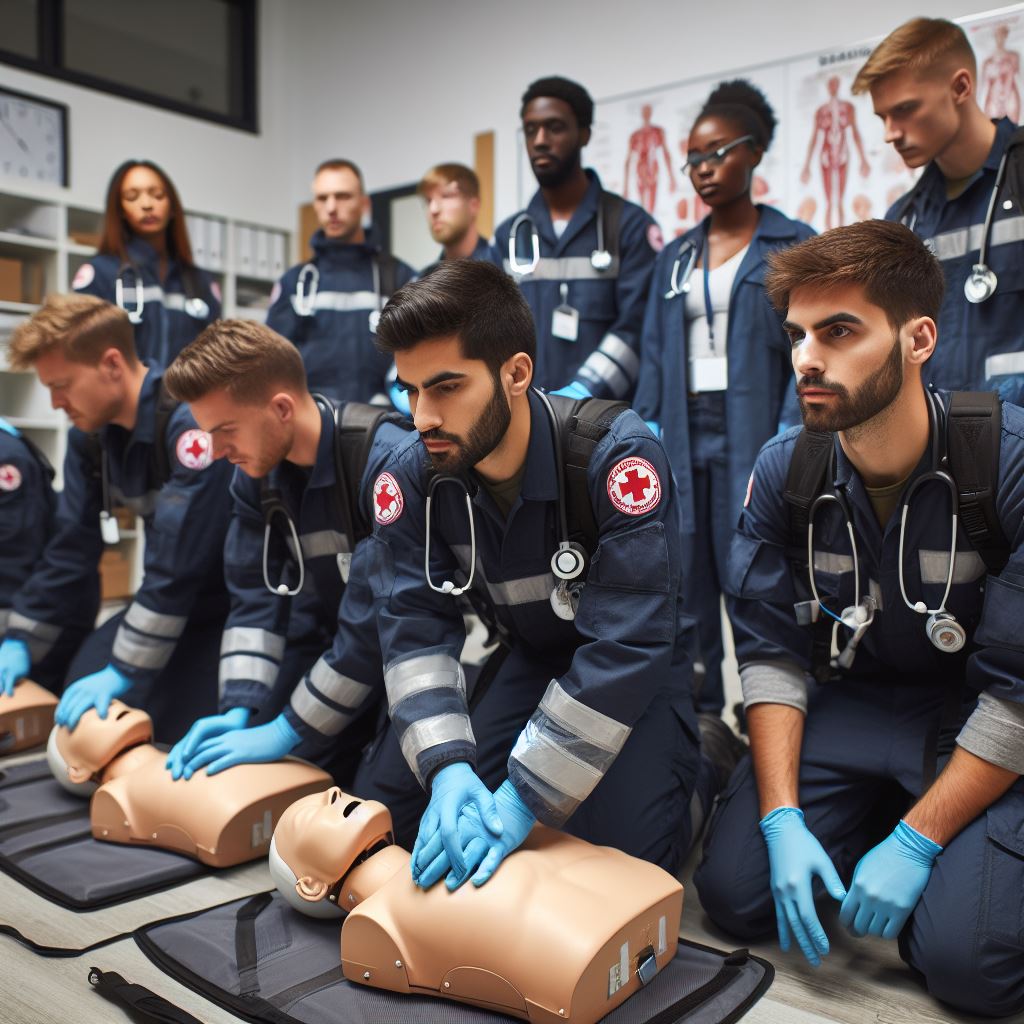Introduction
Welcome to a comprehensive guide on paramedic training in Canada—an insightful journey into this vital healthcare profession.
Understanding the rigorous process and commitments of paramedic training is crucial for aspiring healthcare providers.
In Canada, paramedic training stands as a rigorous and demanding process, delving into both theoretical knowledge and practical applications.
Aspiring paramedics undergo extensive coursework, hands-on training, and clinical placements.
It’s imperative to grasp the multifaceted nature of this training, combining medical expertise, critical thinking, and rapid decision-making skills.
This introduction aims to shed light on the pivotal aspects of paramedic training, highlighting the significance of embracing the challenges and responsibilities it entails.
The intricacies of this training program shape proficient, quick-thinking healthcare professional’s adept at handling emergencies.
Understanding these expectations is fundamental for those embarking on this noble career path.
Throughout this guide, we’ll delve deeper into the core components, training modules, and the rewarding journey of becoming a paramedic in Canada.
Overview of paramedic training
Paramedic training in Canada is rigorous and intense, preparing individuals for a challenging yet rewarding career.
Purpose and Goals of Paramedic Training
- Paramedic training aims to equip individuals with the knowledge and skills necessary to provide emergency medical care.
- The primary goal is to train competent professionals who can respond effectively to a wide range of emergencies.
- Training focuses on developing critical thinking, decision-making, and practical skills required in emergency situations.
Levels of Paramedic Training in Canada
- Primary Care Paramedic (PCP) is the entry level of training for paramedics in Canada.
- Advanced Care Paramedic (ACP) builds upon the knowledge and skills acquired in PCP training.
- Critical Care Paramedic (CCP) training is the highest level and involves additional specialized education.
Duration of Each Level of Training
- PCP training typically takes around 10 to 12 months to complete, including classroom instruction and clinical experience.
- ACP training is an additional 12 to 18 months, with a focus on advanced medical procedures and critical care.
- CCP training varies in duration and can range from 1 to 3 years, depending on the specific program.
Throughout their training, paramedic students participate in a combination of theoretical and practical learning experiences.
They learn how to assess and manage various medical and trauma-related emergencies, including cardiac arrests, respiratory distress, and traumatic injuries.
Students also receive training in administering medications, performing advanced medical procedures, and operating specialized equipment.
Paramedic training programs also emphasize the importance of communication and teamwork in emergency situations.
Students practice effective communication skills and learn how to work efficiently in a multidisciplinary healthcare team.
Additionally, paramedic training includes clinical placements where students gain hands-on experience in real-world healthcare settings.
These placements allow students to apply their knowledge and skills under the supervision of experienced paramedics and healthcare professionals.
Overall, paramedic training in Canada is comprehensive and demanding, preparing individuals for the challenges they will face as paramedics.
Upon successful completion of their training, graduates are eligible to write certification exams to become licensed paramedics.
Continuing education and ongoing professional development are also essential for paramedics to maintain their skills and knowledge.
Paramedics play a crucial role in the healthcare system, providing vital emergency medical care to those in need.
By undergoing rigorous training, paramedics are equipped to save lives and make a positive impact on their communities.
Read: Challenges Faced by Canadian Pharmacists
Admission requirements
When it comes to pursuing a career as a paramedic in Canada, there are certain admission requirements that must be met in order to enter a paramedic training program.
These requirements ensure that aspiring paramedics have the necessary skills and qualifications to provide effective emergency medical care.
In this section, we will discuss the general requirements for entering a paramedic training program in Canada, the importance of meeting these requirements, and any additional requirements specific to certain provinces or programs.
General Requirements
- Educational background: Applicants are typically required to have a high school diploma or equivalent.
- Age: Most paramedic training programs have a minimum age requirement of 18 or 19 years.
- Physical fitness: Candidates must possess good physical health and fitness to handle the demands of the job.
- First aid certification: Basic first aid certification is often required prior to admission.
- Valid driver’s license: Many programs require applicants to have a valid driver’s license.
- Background check: A criminal record check is typically conducted to ensure the safety of patients.
- Medical assessment: Some programs may require a medical assessment to evaluate the candidate’s overall health.
Meeting the Admission Requirements
Meeting the admission requirements for paramedic training programs is crucial for several reasons.
Firstly, it ensures that candidates have the foundational knowledge and skills necessary to succeed in the program.
Secondly, it helps maintain the standards of the paramedic profession, ensuring that only qualified individuals are entrusted with the responsibility of providing emergency medical care.
Finally, meeting the requirements helps minimize potential risks and liability associated with inadequate training and qualifications.
Additional Requirements
In addition to the general requirements, there may be additional requirements specific to certain provinces or programs.
These additional requirements may include:
- Specific educational prerequisites: Some programs may require applicants to have completed specific courses or certifications.
- Language proficiency: Depending on the province, applicants may need to demonstrate proficiency in English or French.
- Immunization requirements: Certain provinces or programs may have specific immunization requirements.
- Driving record: Some programs may require applicants to have a clean driving record.
- Interview or entrance exam: Certain programs may conduct interviews or require applicants to take an entrance exam.
It is important for prospective paramedic students to research the specific admission requirements of the program and province they are interested in.
This will help them adequately prepare and increase their chances of successfully gaining admission.
In fact, entering a paramedic training program in Canada requires meeting certain admission requirements.
These requirements ensure that aspiring paramedics have the necessary qualifications, skills, and physical fitness to provide effective emergency medical care.
Meeting the requirements is not only important for the success of the individual but also for maintaining the standards of the paramedic profession and ensuring patient safety.
Prospective students should be aware of any additional requirements specific to their chosen program or province and adequately prepare to meet them.
Read: Ongoing Education for Pharmacists
Curriculum and courses
Paramedic training programs in Canada are designed to equip individuals with the necessary knowledge and skills to provide emergency medical care.
These programs cover a wide range of topics to ensure that paramedics are prepared for various types of emergencies.
One of the primary topics covered in paramedic training programs is basic life support.
This includes learning how to assess and manage airway, breathing, and circulation in patients who are in cardiac arrest or experiencing respiratory distress.
Paramedics also learn how to perform cardiopulmonary resuscitation (CPR) and use automated external defibrillators (AEDs) to restore normal heart rhythm.
Unlock Your Career Potential
Visualize a clear path to success with our tailored Career Consulting service. Personalized insights in just 1-3 days.
Get StartedAdvanced life support is another crucial component of paramedic training.
Paramedics learn how to administer medications, interpret electrocardiograms (ECGs), and provide advanced airway management.
This includes performing endotracheal intubation and managing patients with severe respiratory or cardiac conditions.
Trauma management is another key aspect of paramedic training.
Paramedics learn how to assess and stabilize patients with traumatic injuries, such as fractures, lacerations, and head injuries.
They also receive training in immobilization techniques and pre-hospital trauma care protocols.
Comprehensive Training: Theory, Practice, and Specialized Skills for Paramedics
In addition to these core topics, paramedic training programs may offer specialized courses or electives based on the interests and needs of the students.
These courses can include pediatric advanced life support, which focuses on managing emergencies in children, and geriatric care, which covers the unique needs and challenges of elderly patients.
The curriculum of paramedic training programs is designed to strike a balance between theoretical knowledge and practical skills training.
Paramedics need to have a solid understanding of anatomy, physiology, and pathophysiology to effectively assess and treat patients.
However, practical skills training is equally important to ensure that paramedics can confidently and competently perform critical interventions in real-life emergencies.
Throughout their training, paramedic students have numerous opportunities to apply their theoretical knowledge in practical scenarios.
This includes hands-on practice in simulated emergency situations and clinical placements in hospitals and pre-hospital settings.
These experiences allow students to develop their critical thinking, problem-solving, and communication skills.
In short, paramedic training programs in Canada cover a wide range of topics, from basic life support to trauma management.
While the curriculum includes theoretical knowledge, the emphasis is also placed on practical skills training to ensure that paramedics are well-prepared to provide emergency medical care in various situations.
Read: Canadian Pharmacists’ Role in Healthcare

Clinical and practical experience
Importance of Gaining Hands-on Experience
Gaining hands-on experience is essential during paramedic training as it allows students to apply theoretical knowledge in real-life situations.
- Provides an opportunity to develop critical thinking and problem-solving skills.
- Allows students to practice and refine their technical skills under professional supervision.
- Enhances confidence and prepares students for the challenges they may face in the field.
- Improves decision-making abilities in high-pressure situations.
- Promotes teamwork and effective communication with patients, healthcare professionals, and other first responders.
Typical Clinical and Practical Components
Paramedic training programs consist of various clinical and practical components to ensure comprehensive education in emergency medical care.
- Clinical Observerships: Students observe experienced paramedics during their shifts to gain a deeper understanding of the profession.
- Simulated Scenarios: Trainees participate in simulated emergencies to practice patient assessment, treatment, and decision-making.
- Practicum Placements: Students work under the guidance of experienced trainers in controlled settings to apply their skills.
- Field Rotations: Trainees accompany paramedics on real emergency calls to gain firsthand experience.
- Specialized Skills Training: Programs provide training in specialized areas like advanced cardiac life support or trauma care.
Settings where Students Gain Experience
During their training, students have the opportunity to gain experience in various healthcare settings.
- Ambulance Services: Trainees spend time on ambulances, responding to emergency calls alongside experienced paramedics.
- Hospitals: Students may rotate through emergency departments, observing and assisting healthcare professionals.
- Specialized Care Units: Some programs arrange placements in intensive care units or critical care transport teams.
- Community Clinics: Trainees may work alongside primary care providers, gaining experience in non-emergency medical care.
- Disaster Response: Students may participate in disaster drills or assist on actual disaster scenes.
In essence, gaining clinical and practical experience is vital for a successful paramedic training journey.
It prepares students with the necessary skills, knowledge, and confidence to provide effective emergency medical care.
Through hands-on experience, future paramedics are equipped to handle diverse situations with professionalism and compassion.
Read: Retail vs Hospital Pharmacy in Canada
You Might Also Like: Paramedics and Community Outreach Programs
Certification and licensing
- Paramedic certification in Canada demands rigorous training and examination.
- Completion of accredited programs is mandatory for aspiring paramedics.
- Program duration varies based on the sought certification level.
- The National Association of Career Colleges administers the crucial certification exam.
- This comprehensive test evaluates diverse emergency care skills and knowledge.
- Passing grants, the Certified Paramedic (CP) title in Canada.
- Paramedics need provincial or territorial licenses, apart from certification.
- Each province or territory governs licensing through a regulatory body.
- Ontario, for example, entrusts paramedic oversight to the College of Paramedics.
- CPO mandates specific education and exam criteria for licensing.
- Paramedics must meet renewal requisites for certification and licensing maintenance.
- These may include earning continuing education credits and undergoing skill assessments.
- Maintaining Basic and Advanced Life Support certifications is obligatory.
- Provincial and territorial regulatory bodies ensure paramedic competency and professionalism.
- They establish standards, handle complaints, and monitor ethical conduct.
- Certification and licensing assure the public of paramedics’ competence.
- Assurance of quality care fosters trust among patients and families.
- Paramedics must stay current with evolving practices through ongoing certification.
- Continuous learning fosters a high standard of patient care.
- Certification and licensing are pivotal for ensuring safety and care quality.
Challenges and rewards
Paramedic training in Canada is a rigorous and demanding process that requires dedication, resilience, and a passion for helping others.
While the training presents various challenges, the rewards and fulfillment that come with a career as a paramedic make it all worthwhile.
Challenges Faced During Paramedic Training
- Intensity: Paramedic training is highly intensive, both physically and mentally, pushing individuals to their limits.
- Long hours: Trainees must be prepared for long hours of study, clinical rotations, and on-the-job training.
- Emotional toll: Paramedic work involves witnessing traumatic events and dealing with life-and-death situations, taking an emotional toll on trainees.
- Physical demands: Paramedics are often required to lift and carry heavy equipment, work in challenging environments, and handle physically demanding tasks.
- High-pressure situations: Trainees must learn to stay calm and make critical decisions quickly in high-pressure situations.
Despite these challenges, the rewards and fulfillment of a career as a paramedic make it a highly gratifying profession.
Rewards and Fulfillment as a Paramedic
- Helping others: As a paramedic, you have the opportunity to make a real difference in people’s lives, providing crucial medical care in their time of need.
- Saving lives: Being able to save someone’s life through your knowledge, skills, and quick response is an incredibly rewarding experience.
- Variety: Paramedics encounter a wide range of medical emergencies, ensuring that every day on the job is unique and offers new challenges.
- Teamwork: Paramedics work closely with other healthcare professionals, fostering a strong sense of teamwork and camaraderie.
- Job stability: The demand for paramedics is growing, ensuring job security and stability in the healthcare field.
It is important for aspiring paramedics not to be discouraged by the challenges of training.
Instead, they should see them as opportunities for growth and personal development.
With the right mindset and determination, it is possible to overcome these challenges and embark on a rewarding career as a paramedic.
During the training process, aspiring paramedics receive comprehensive education and hands-on experience to prepare them for the demands of the job.
They learn essential skills such as administering CPR, assessing patients’ conditions, providing emergency medical treatment, and operating life-saving equipment.
Moreover, trainees gain practical experience through clinical rotations and ride-alongs with experienced paramedics.
These opportunities allow them to apply their knowledge in real-life situations and learn how to work effectively as part of a team.
The road to becoming a paramedic in Canada may be challenging, but those who are passionate about helping others and making a difference in their communities will find it immensely fulfilling.
The combination of adrenaline, teamwork, and the gratitude of patients and their families make the career of a paramedic truly rewarding.
So, if you are considering a career as a paramedic, embrace the challenges, stay committed to your training, and remember the incredible rewards that await you in this noble profession.
Find Out More: Networking for Med Techs in Canada
Conclusion
Paramedic training in Canada is rigorous and demanding but offers a rewarding career path.
It is essential to understand the expectations and requirements before pursuing this field.
Throughout this blog post, we have discussed the various aspects of paramedic training in Canada.
We have explored the educational requirements, the skills and knowledge needed, and the physical and mental demands of the job.
It is crucial to recognize the importance of this training, as paramedics play a critical role in saving lives and providing necessary medical assistance.
They are the first responders in emergency situations, and their quick thinking and efficient actions can make a significant difference in patient outcomes.
For those considering a career in paramedicine, it is highly recommended to further explore the training options available.
Researching accredited programs and understanding the specific requirements for each province is crucial.
Becoming a paramedic can be a challenging yet fulfilling career choice.
It offers an opportunity to make a meaningful impact in people’s lives.
By learning about what to expect and preparing adequately, individuals can pursue a rewarding career in this field of healthcare.




